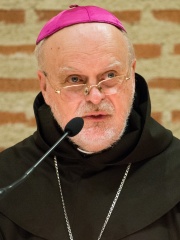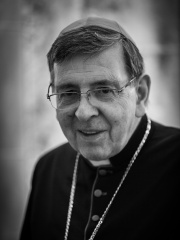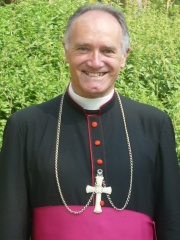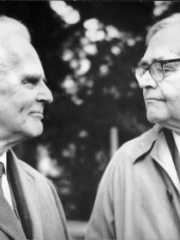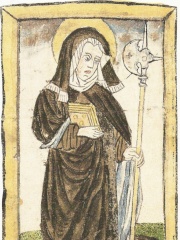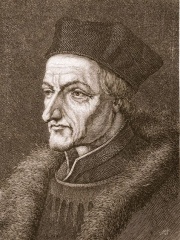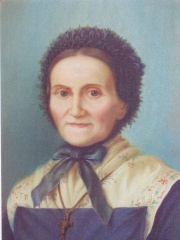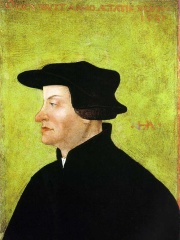
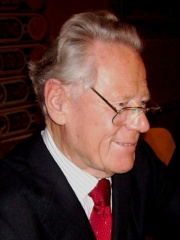
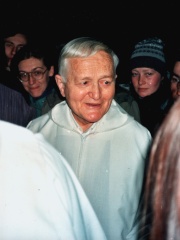
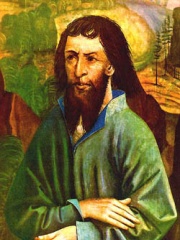
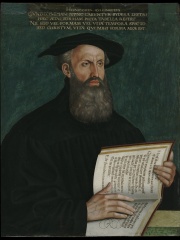


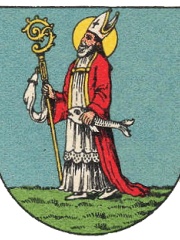
The Most Famous
RELIGIOUS FIGURES from Switzerland
This page contains a list of the greatest Swiss Religious Figures. The pantheon dataset contains 2,238 Religious Figures, 25 of which were born in Switzerland. This makes Switzerland the birth place of the 18th most number of Religious Figures behind Iran and Japan.
Top 10
The following people are considered by Pantheon to be the top 10 most legendary Swiss Religious Figures of all time. This list of famous Swiss Religious Figures is sorted by HPI (Historical Popularity Index), a metric that aggregates information on a biography’s online popularity. Visit the rankings page to view the entire list of Swiss Religious Figures.

1. Huldrych Zwingli (1484 - 1531)
With an HPI of 74.60, Huldrych Zwingli is the most famous Swiss Religious Figure. His biography has been translated into 83 different languages on wikipedia.
Huldrych or Ulrich Zwingli (1 January 1484 – 11 October 1531) was a leader of the Reformation in Switzerland, born during a time of emerging Swiss patriotism and increasing criticism of the Swiss mercenary system. He attended the University of Vienna and the University of Basel, a scholarly center of Renaissance humanism. He continued his studies while he served as a pastor in Glarus and later in Einsiedeln, where he was influenced by the writings of Erasmus. In 1519, Zwingli became the Leutpriester (people's priest) of the Grossmünster in Zürich where he began to preach ideas on reform of the Catholic Church. In his first public controversy in 1522, he attacked the custom of fasting during Lent. In his publications, he noted corruption in the ecclesiastical hierarchy, promoted clerical marriage, and attacked the use of images in places of worship. Among his most notable contributions to the Reformation was his expository preaching, starting in 1519, through the Gospel of Matthew, before eventually using Biblical exegesis to go through the entire New Testament, a radical departure from the Catholic mass. In 1525, he introduced a new communion liturgy to replace the Mass. He also clashed with the Anabaptists, which resulted in their persecution. Historians have debated whether or not he turned Zürich into a theocracy. The Reformation spread to other parts of the Swiss Confederation, but several cantons resisted, preferring to remain Catholic. Zwingli formed an alliance of Reformed cantons which divided the Confederation along religious lines. In 1529, a war was averted at the last moment between the two sides. Meanwhile, Zwingli's ideas came to the attention of Martin Luther and other reformers. They met at the Marburg Colloquy and agreed on many points of doctrine, but they could not reach an accord on the doctrine of the Real Presence of Christ in the Eucharist. In 1531, Zwingli's alliance applied an unsuccessful food blockade on the Catholic cantons. The cantons responded with an attack at a moment when Zürich was ill-prepared, and Zwingli died on the battlefield. His legacy lives on in the confessions, liturgy, and church orders of the Reformed churches of today.

2. Hans Küng (1928 - 2021)
With an HPI of 64.58, Hans Küng is the 2nd most famous Swiss Religious Figure. His biography has been translated into 42 different languages.
Hans Küng (German: [ˈhans ˈkʏŋ]; 19 March 1928 – 6 April 2021) was a Swiss Catholic priest, theologian, and author. From 1995 he was president of the Foundation for a Global Ethic (Stiftung Weltethos). Küng was ordained a priest in 1954, joined the faculty of the University of Tübingen in 1960, and served as a theological adviser during the Second Vatican Council. In 1978, after he rejected the doctrine of papal infallibility, he was not allowed to continue teaching as a Catholic theologian, but he remained at Tübingen as a professor of ecumenical theology until he retired with the title professor emeritus in 1996. He remained a Catholic priest until his death. He supported the spiritual substance of religion, while questioning traditional dogmatic Christianity. He published Christianity and the world religions: paths of dialogue with Islam, Hinduism, and Buddhism in 1986, wrote Dying with Dignity together with Walter Jens in 1998, and signed the appeal Church 2011, The Need for a New Beginning. He was awarded honorific doctorates internationally, and received numerous awards including the Otto Hahn Peace Medal in 2008. An asteroid is named after him.

3. Brother Roger (1915 - 2005)
With an HPI of 61.91, Brother Roger is the 3rd most famous Swiss Religious Figure. His biography has been translated into 32 different languages.
Roger Schutz (12 May 1915 – 16 August 2005), popularly known as Brother Roger (French: Frère Roger), was a Swiss Christian leader and monastic brother. In 1940 Schutz founded the Taizé Community, an ecumenical monastic community in Burgundy, France, serving as its first prior until his murder in 2005. Towards the end of his life, the Taizé Community was attracting international attention, welcoming thousands of young pilgrims every week, which it has continued to do after his death.

4. Nicholas of Flüe (1417 - 1487)
With an HPI of 60.55, Nicholas of Flüe is the 4th most famous Swiss Religious Figure. His biography has been translated into 21 different languages.
Nicholas of Flüe (German: Niklaus von Flüe; 1417 – 21 March 1487) was a Swiss hermit and ascetic who is the patron saint of Switzerland. He is sometimes invoked as Brother Klaus. A farmer, military leader, member of the assembly, councillor, judge and mystic, he was respected as a man of complete moral integrity. He is known for having fasted for over twenty years. Brother Klaus's counsel to the Diet of Stans (1481) helped prevent war between the Swiss cantons.
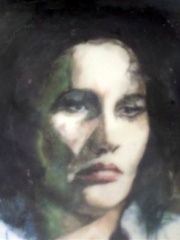
5. Anna Göldi (1734 - 1782)
With an HPI of 59.84, Anna Göldi is the 5th most famous Swiss Religious Figure. Her biography has been translated into 19 different languages.
Anna Göldi (also Göldin or Goeldin, 24 October 1734 – 13 June 1782) was an 18th-century Swiss housemaid who was one of the last persons to be executed for witchcraft in Europe. Göldi, who was executed by decapitation in Glarus, has been called the "last witch" in Switzerland. She was posthumously exonerated by the government of the canton of Glarus in 2008.

6. Heinrich Bullinger (1504 - 1575)
With an HPI of 59.46, Heinrich Bullinger is the 6th most famous Swiss Religious Figure. His biography has been translated into 31 different languages.
Heinrich Bullinger (18 July 1504 – 17 September 1575) was a Swiss Reformer and theologian, the successor of Huldrych Zwingli as head of the Church of Zürich and a pastor at the Grossmünster. One of the most important leaders of the Swiss Reformation, Bullinger co-authored the Helvetic Confessions and collaborated with John Calvin to work out a Reformed doctrine of the Lord's Supper.

7. Jacob Sprenger (1435 - 1495)
With an HPI of 59.35, Jacob Sprenger is the 7th most famous Swiss Religious Figure. His biography has been translated into 17 different languages.
Jacob Sprenger (also James, 1436/1438 – 6 December 1495) was a Dominican inquisitor and theologian principally known for his association with a well-known guide for witch-hunters from 1486, Malleus Maleficarum. He was born in Rheinfelden, Further Austria, taught at the University of Cologne, and died in 1495 in Strasbourg.

8. Jakob Ammann (1644 - 1730)
With an HPI of 57.61, Jakob Ammann is the 8th most famous Swiss Religious Figure. His biography has been translated into 24 different languages.
Jakob Ammann (also Jacob Amman, Amann; 12 February 1644 – between 1712 and 1730) was a Swiss Anabaptist leader and the namesake of the Amish religious movement.

9. Ulrich of Augsburg (890 - 973)
With an HPI of 57.02, Ulrich of Augsburg is the 9th most famous Swiss Religious Figure. His biography has been translated into 21 different languages.
Ulrich of Augsburg (890 – 4 July 973), sometimes spelled Uodalric or Odalrici, was Prince-Bishop of Augsburg in the Holy Roman Empire. He was the first saint to be canonized not by a local authority but by the pope.
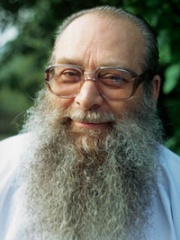
10. Billy Meier (1937 - )
With an HPI of 56.91, Billy Meier is the 10th most famous Swiss Religious Figure. His biography has been translated into 25 different languages.
Eduard Albert Meier (born 3 February 1937), commonly nicknamed "Billy", is the founder of a UFO religion called the "Freie Interessengemeinschaft für Grenz- und Geisteswissenschaften und Ufologiestudien" (Free Community of Interests for the Border and Spiritual Sciences and Ufological Studies) and alleged contactee whose UFO photographs are claimed to show alien spacecraft. Meier claims to be in regular contact with extraterrestrial beings he calls the Plejaren. He also presented other material during the 1970s such as metal samples, sound recordings and film footage. Meier claims to be the seventh reincarnation after six prophets common to Judaism, Christianity, and Islam: Enoch, Elijah, Isaiah, Jeremiah, Immanuel (Jesus), and Muhammad. Meier has been widely characterized as a fraud by skeptics and ufologists, who suggest that he used models to hoax photos claimed to show alien spacecraft. Meier's prophecies repeatedly blame Jews (whom he refers to as "gypsies") for future atrocities.
Pantheon has 25 people classified as religious figures born between 890 and 1958. Of these 25, 4 (16.00%) of them are still alive today. The most famous living religious figures include Billy Meier, Anders Arborelius, and Kurt Koch. The most famous deceased religious figures include Huldrych Zwingli, Hans Küng, and Brother Roger. As of April 2022, 5 new religious figures have been added to Pantheon including Wiborada, Maria Bernarda Bütler, and Johann Geiler von Kaysersberg.
Living Religious Figures
Go to all Rankings
Billy Meier
1937 - Present
HPI: 56.91
Anders Arborelius
1949 - Present
HPI: 51.67
Kurt Koch
1950 - Present
HPI: 51.00
Bernard Fellay
1958 - Present
HPI: 45.99

Deceased Religious Figures
Go to all Rankings
Huldrych Zwingli
1484 - 1531
HPI: 74.60
Hans Küng
1928 - 2021
HPI: 64.58
Brother Roger
1915 - 2005
HPI: 61.91
Nicholas of Flüe
1417 - 1487
HPI: 60.55
Anna Göldi
1734 - 1782
HPI: 59.84
Heinrich Bullinger
1504 - 1575
HPI: 59.46
Jacob Sprenger
1435 - 1495
HPI: 59.35
Jakob Ammann
1644 - 1730
HPI: 57.61
Ulrich of Augsburg
890 - 973
HPI: 57.02
Emil Brunner
1889 - 1966
HPI: 55.00
Maurice Bavaud
1916 - 1941
HPI: 53.98
Henri Schwery
1932 - 2021
HPI: 53.47

Newly Added Religious Figures (2022)
Go to all Rankings
Wiborada
900 - 926
HPI: 53.41
Maria Bernarda Bütler
1848 - 1924
HPI: 50.67
Johann Geiler von Kaysersberg
1445 - 1510
HPI: 50.17
Marguerite Bays
1815 - 1879
HPI: 46.80
Bruno Heim
1911 - 2003
HPI: 45.17

Which Religious Figures were alive at the same time? This visualization shows the lifespans of the 12 most globally memorable Religious Figures since 1700.

